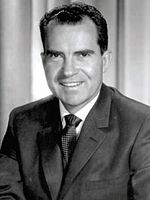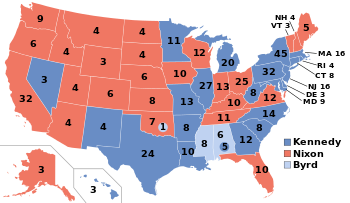1960 U.S. Presidential election
|
|
|||||||||||||||||||||||||||||
|---|---|---|---|---|---|---|---|---|---|---|---|---|---|---|---|---|---|---|---|---|---|---|---|---|---|---|---|---|---|
|
|||||||||||||||||||||||||||||
|
All 537 electoral votes of the Electoral College 269 electoral votes needed to win |
|||||||||||||||||||||||||||||
| Turnout | 62.8% |
||||||||||||||||||||||||||||
|
|||||||||||||||||||||||||||||
|
Presidential election results map. Blue denotes states won by Kennedy/Johnson, red denotes those won by Nixon/Lodge, orange denotes the electoral votes for Byrd/Thurmond by Alabama and Mississippi unpledged electors, and a vote for Byrd/Goldwater by an Oklahoma faithless elector. Numbers indicate the number of electoral votes allotted to each state.
|
|||||||||||||||||||||||||||||
|
|||||||||||||||||||||||||||||
Dwight D. Eisenhower
Republican
The United States presidential election of 1960 was the 44th quadrennial presidential election, held on Tuesday, November 8, 1960. The Republican Party nominated incumbent Vice President Richard Nixon, while the Democratic Party nominated John F. Kennedy, U.S. Senator from Massachusetts. The incumbent President, Republican Dwight D. Eisenhower, was not eligible for re-election after being elected the maximum two times allowed by the Twenty-second Amendment; he was the first President denied the choice to run for a third term by that amendment. This was the first presidential election in which voters in Alaska and Hawaii were able to participate, as both had become states in 1959.
Kennedy is generally considered to have won the national popular vote by 112,827, a margin of 0.17% (although the unusual nature of the election in Alabama has caused some to question this figure), and though Nixon carried more individual states (26 to 22), Kennedy won a 303 to 219 Electoral College victory.
...
Wikipedia




